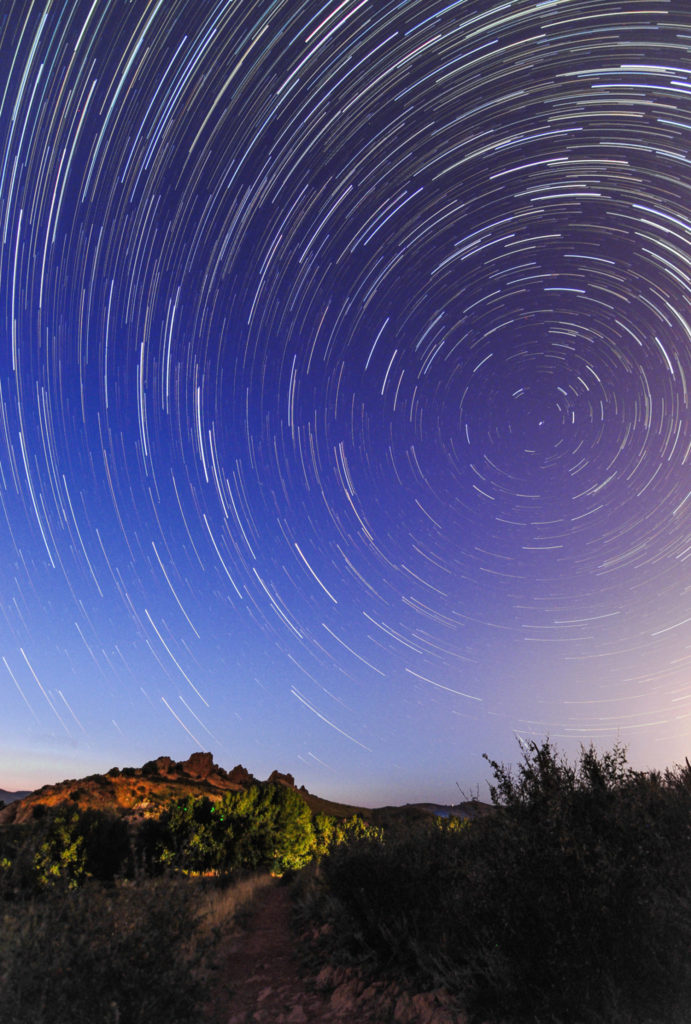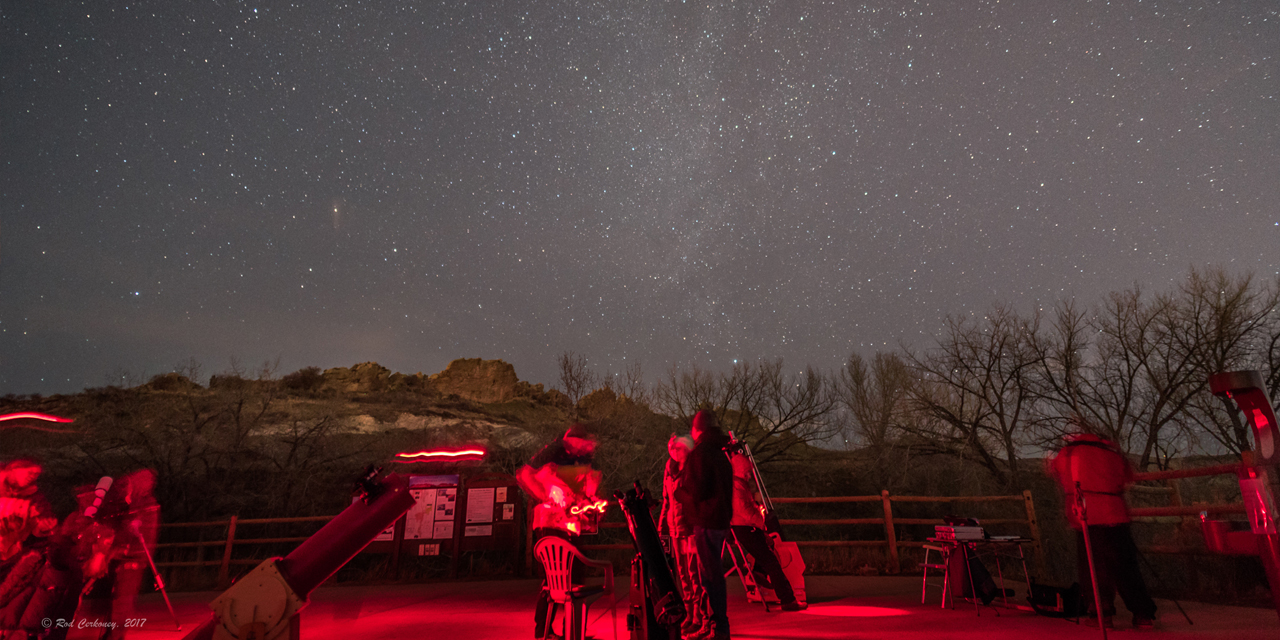The night sky appears to be an enchanting curtain of blue-black velvet scattered with profuse pinpoints of starlight. Some are prominent sparkling celestial bodies, others are scattered diamond dust across deep space. Astronomy enthusiasts find Northern Colorado, with its lack of light pollution, to be an ideal place to view the night sky.
Due to the busy pace of modern life, we often forget to look up. In the process of doing so, though, a connection is formed, with an infinite universe, certainly, but a flow from past to present is also achieved. People throughout history, beginning with ancient civilizations, have gazed in wonder at the same stars and constellations as can be observed today while inspired to ponder about the future.
In an effort to promote stargazing as an entertaining as well as educational activity, area organizations offer free public events.
Rediscover an appreciation for the true dark of night where nebulae and galaxies, including the Milky Way, glide into view beyond the glare of city lights.
Devil’s Backbone After Hours
In fact, reconnecting with the dark is one of the first things noticeable when attending a monthly stargazing event at the base of Devil’s Backbone, hosted by Larimer County Department of Natural Resources (LCDNR), in conjunction with volunteers from Northern Colorado Astronomical Society (NCAS).
Although the venue at the trailhead parking lot isn’t too far west of Loveland, the distance is enough to escape municipal illumination.
According to Ann Donoghue, NCAS president, this is a real contemporary issue. “As our population grows, and more lighting is added, our skies are becoming brighter and less of the night sky is visible. This is especially true in areas that don’t have any lighting codes, or where codes haven’t been enforced, or lighting upgrades haven’t been made.”
The true extent of light pollution becomes obvious once away from society’s incessant steady shine.

Using extended exposure photography, Polaris, which is in line with the Earth’s rotational axis, appears stationary as the other stars appear to rotate around it. This photo captures about 90 minutes of movement.
With no moonlight and just a tad of ambient starlight, the setting takes on an almost ethereal quality. The tread of footfalls on gravel is soft, voices are subdued, and illumination comes from red-beamed flashlights, which are the acceptable type when stargazing. The spectrum of faint red light is conducive to focusing in the dark, whereas the intense blueish tint of LED’s isn’t (unless the lens is covered by two layers of red duct tape). Cell phones should also be dimmed out of courtesy for others.
Six large, portable telescopes are set up on a cement pad, manned by volunteers from NCAS, all of whom pride themselves in their knowledge about night skies as well as a willingness to share information with the public. These are family-friendly events, so all ages are welcome, but due to high-tech equipment on the premises, young children should be supervised.
On a chilly February night Andromeda, the Orion Nebula, and open star clusters are all visible.
When asked how long it takes double stars to circle each other, a witty voice issues from a nearby bundled up face, “Only 200,000 years or so. We won’t see it tonight.”
Rod Cerkoney, LCDNR volunteer naturalist, is on hand “as a liaison between the public and NCAS,” of which he is also a member. He ensures visitors connect with presenters to properly view awe-inspiring overhead features and get questions answered.
LCDNR community relations specialist Teddy Parker-Renga clarifies why these events are important. “Larimer County Natural Resources provides night sky programs to connect the community to our parks and open spaces in a unique way. People don’t often have the opportunity to see the intricacies and beauty of the night sky in urban areas, so offering these programs at places close to town is a way for people to have those experiences,” says Parker-Renga.
Various locations are offered throughout the year, including Fossil Creek, Carter Lake, Bobcat Ridge and others. Visit www.nocoastro.org or www.larimer.org/naturalresources for a full seasonal listing.
Spring of 2018 brings good views of such constellations as Leo and Canis Minor, with its one brilliant blue-white star, Procyon. Auriga and Perseus are along the horizon, with the Big Dipper taking center stage.
Programs during the summer months will start later in the evening due to increased daylight hours. However, time spent stargazing is often more thorough because warmer temperatures encourage folks to stay out longer.
“People should really try to attend an event in the July to September timeframe to see the four ‘best’ planets,” says Greg Halac, NCAS vice president and outreach coordinator. “Venus, Mars, Jupiter and Saturn are all in the evening sky.”
Area Observatories
Little Thompson Observatory
The Little Thompson Observatory is on the far northeast quadrant of the Berthoud High School campus. Whereas flashlights are frowned upon at Devil’s Backbone and other outdoor venues, one is needed at Little Thompson to navigate the well-defined yet unlit pathway from parking lot to facility. Considered unique in that it is a community observatory run completely by volunteers, the venue offers free Public Star Nights the third Friday of each month. Each lecture in the popular series hosts an expert in fields related to astronomy, physics or astrophysics, offering inside intel on a variety of subjects. After the program, use of the telescopes is available, depending on weather. Cost: free, donations welcome. In addition, the observatory can be reserved for private functions. For more information, visit www.starkids.org.
Stargazer Observatory
The Stargazer Observatory is operated by Front Range Community College. Partnering with Village Homes, this venue at 3733 Galileo Drive is part of an astronomy laboratory at Observatory Village in southeast Fort Collins. A monthly public open house is held the third Saturday of the month. Times vary depending on the season. Weather is always a factor, so visit the website before heading out to ensure an event is still on schedule.
For more information, visit www.stargazerobservatory.com.
Sunlight Peak Observatory
Also operated by Front Range Community College Sunlight Peak Observatory, is on campus at 4616 Shields, Fort Collins, directly behind the Harmony Library. Public open houses take place the first Friday of the month. April and May are good viewing times, but the facility does not hold these events in June or July.
Lynette Chilcoat is a Loveland-based writer. To comment on this article, send an email to letters@nocostyle.com.






